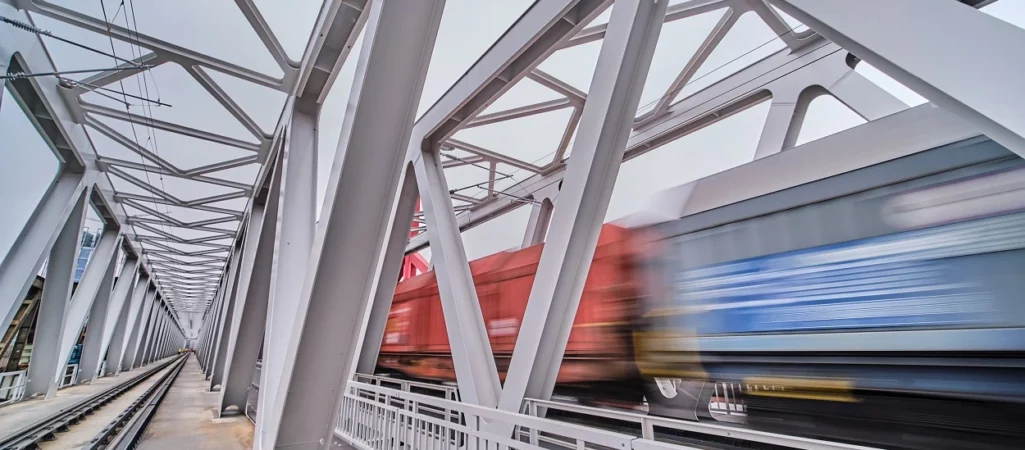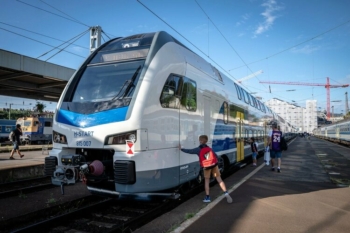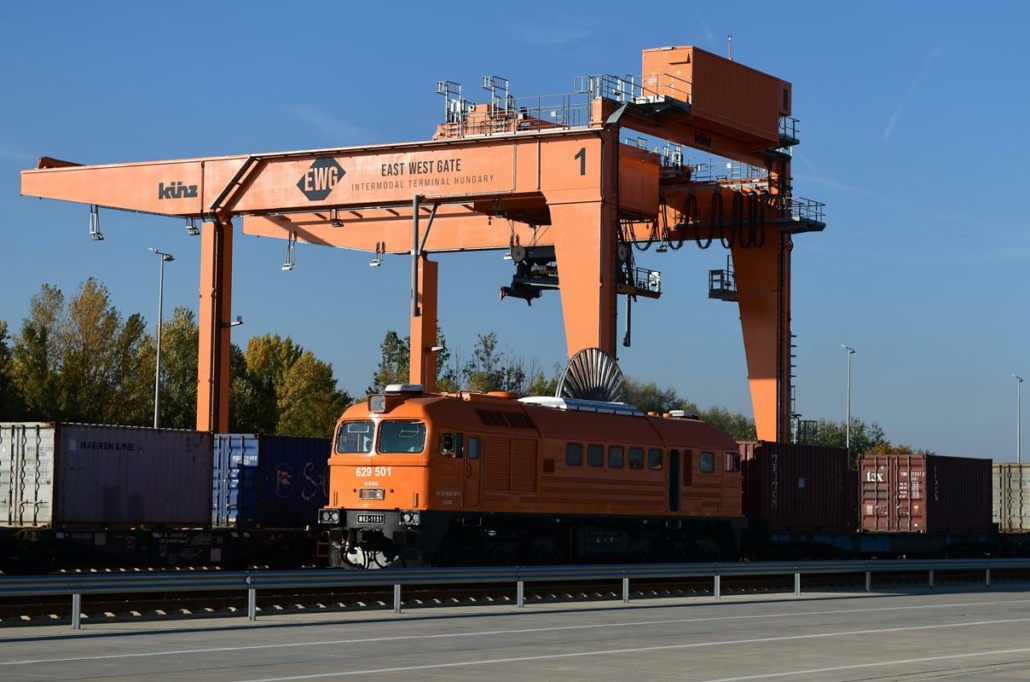Europe’s largest onshore intermodal logistics terminal opened near Ukraine border
Europe’s largest and most modern green concept land-based intermodal terminal has been built in record time, with a private investment of more than HUF 40 billion, in Fényeslitke, in the immediate vicinity of the Hungarian-Ukrainian border. Located at the junction of the wide and standard gauge railway tracks, the East-West Gate (EWG) can handle up to one million 20-foot containers per year and is suitable for loading trucks and conventional road semi-trailers onto rail. The EWG also has a significant capacity for transhipment of agricultural products, hence could soon become the largest rail hub for Ukrainian food exports. The first train carrying Ukrainian agricultural goods rolled into the terminal at the handover ceremony
Following the preparatory works, construction of the East-West Gate terminal started in January 2021 on an 85-hectare site the size of Margaret Island. A total of 10 kilometres of standard and wide-gauge railway track and 225,000 square metres of concrete pavement were built. A warehouse of 15,000 square metres is also available for use by the partners, and there is also the possibility of building additional loading and assembly facilities on the 140-hectare development site. EWG received the railway licence from the National Transport Authority in June, after a successful technological and technical trial run, which started in March this year and lasted several months.
Minister Szijjártó inaugurates the railway intermodal combi terminal
Péter Szijjártó, the minister of foreign affairs and trade, inaugurated a 30 billion forint (EUR 73m) railway intermodal combi terminal in Fényeslitke, near Hungary’s border with Ukraine, on Tuesday.
Addressing the ceremony, Szijjártó said
the terminal will play an “enormous role” in facilitating exports of Ukrainian grain to trade routes on the Adriatic.
The terminal’s transshipment capacity will reach about 800 tonnes of grain per hour, while annual capacity is set to reach 1 million containers, he said.
He noted that the largest and most modern railway intermodal combi terminal in Europe had been completed in record time and using digital solutions. It will allow fast and safe loading of four 740-metre-long trains at the same time, he added. About 500 people will work at the East-West Gate terminal, Szijjártó said.
A new dimension in freight transport – revitalising the logistics area
In the region, which until 1990 was a major transit region for freight and a major source of employment, freight traffic and transhipment, necessitated by the gauge change, has been reduced in recent decades. However, the privately built EWG was completed in just over a year and can handle significant freight traffic with state-of-the-art technology.
The terminal can handle up to one million twenty-foot containers (TEUs) per year, making it the largest such facility on the continent in terms of theoretical capacity and area. The terminal is capable of trans loading containers between wide gauge and standard gauge, as well as between rail trains and trucks. EWG is also suitable for loading trucks and conventional road semi-trailers onto rail. This will allow to shift as much as possible of the freight traffic arriving by truck at the EU border to rail, in line with the EU’s climate objectives. EWG’s cranes are ATEX and ADR certified, so they can also trans load special materials such as gas container tanks and chemicals.

The EWG also prepared for trans loading Ukrainian agricultural products, adapting to the war situation. From November 2022, it is expected to be capable of handling 800 tonnes of grain and 450 cubic metres of sunflower oil per hour, making it the largest rail hub for Ukrainian food exports. At the inauguration ceremony, the first train carrying Ukrainian agricultural goods, an EWG-organised consignment, rolled into the terminal. A total of 1,146 tons of wheat, millet and green peas shipped by Ugrain Trade LLC arrive in 44 twenty-foot containers, and after transshipment, they are transported to the Csepel Free Port.
“With the construction of the East-West Gate, Hungary is back on the map of international rail logistics“- stressed János Tálosi. The CEO of the investor East-West Intermodal Logistics Zrt. added that the most advanced technologies available have been incorporated into the terminal, making transport faster and more accurate. “EWG is independent and its services are available to any rail and road freight company in the world, open to all freight forwarding operators and carriers“
– said János Tálosi.

Read alsoHungarian railways aiding delivery of Ukraine grain
5G and 3D digital twin at the 21st century terminal
EWG is the first in Europe to control cranes remotely using 5G technology. The terminal has a 41-metre wide and two 28-metre wide giant cranes on rails, as well as a 20-metre high rubber-tyre crane. The cranes, supplied by Austrian company Künz, are equipped with 20 high-resolution cameras, which, with the help of 5G, can be viewed in real time at the centre of the terminal and can react in the same way, without delay, so that they can control the cranes as if they were working in the crane cabin. The private 5G network required for this was built by Vodafone Hungary and the network equipment was supplied by Huawei.
“Investments in private 5G networks will clearly pay off, as new industrial and logistical business models can be built on next-generation mobile networks, which can contribute to the development of Hungarian companies, job creation, and last but not least, stimulate exports and make Hungary an attractive destination. A great example of this is the private 5G network deployed at the East-West Gate terminal, whose increased speed, capacity and minimal latency will enable the efficient and flexible operation of a smart rail combined terminal equipped with the latest devices, technologies, control and security equipment“
– said Mátyás Dobó, Deputy CEO of Vodafone Hungary’s Corporate Services Business Unit.
A realistic virtual twin of the terminal (Digital Twin) has also been created, which tracks the processes and operations of the logistics centre in real time and in 3D – the movement of trains, trucks, cranes, delivery vehicles and goods. Developed in cooperation between a Hungarian start-up and EWG, the solution is a world first in terms of complexity. MaxWhere collects, processes and displays information from all the subsystems of the logistics centre in real time, helping to plan, optimise and increase efficiency in accordance with the principles of Industry 4.0, using the terminal’s own 5G network.
Job creation and development in a lagging region
The investment, which was completely privately funded with more than HUF 40 billion, has directly created around 100 new jobs in the disadvantaged region, with further job growth expected by the middle of next year. In addition, the terminal will indirectly create jobs for five hundred people. Related to this investment, the company has carried out several billion HUF worth of improvements to the public rail network.

Read alsoWill Hungary produce railway vehicles in the future?
please make a donation here
Hot news
Yay or nay? – 6 odd Hungarian delicacies that make our skin crawl
Budapest tourism “exploded” this past weekend
Container transport in Budapest may stop: How will this affect Hungarian economy?
Minister: Hungary will protect its territory by every means possible
Orbán cabinet may double airspace fee: another ticket price increase?
Hungary expanding the list of prohibited designer drugs




